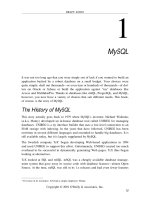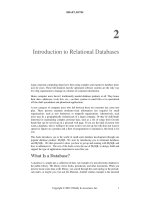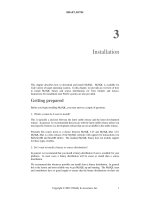Hướng dẫn sử dụng MySQL part 12 pot
Bạn đang xem bản rút gọn của tài liệu. Xem và tải ngay bản đầy đủ của tài liệu tại đây (75.5 KB, 12 trang )
DRAFT, 9/10/01
Copyright
2001 O’Reilly & Associates, Inc.
1
C API
In this book,, we examine several different programming languages, Python, Java, Perl,
PHP and C. Of these languages. C/C++ is by far the most challenging. With the other
languages, your primary concern is the formulation of SQL, the passing of that SQL to a
function call, and the manipulation of the resulting data. C adds the very complex issue of
memory management into the mix.
MySQL provides C libraries that enable the creation of MySQL database applications.
MySQL derives its API very heavily from mSQL, and older database server still used to
back-end many Internet web sites. However, due to it's extensive development, MySQL is
much more feature-rich than mSQL. In this chapter, we will examine the details of the
MySQL C API by building an object-oriented C++ API than can be used to interface C++
programs to a MySQL database server.
The API
Whether you are using C or C++, the MySQL API is the gateway into the database. How
you use it, however, can be very different depending on whether you are using C or the
object-oriented features of C++. C database programming must be attacked in a linear
fashion, where you step through your application process to understand where the
database calls are made and where clean up needs to occur. Object-oriented C++, on the
other hand, requires an OO interface into the API of your choice. The objects of that API
can then take on some of the responsibility for database resource management.
Table 13-1 shows the function calls of the MySQL C API. We will go into the details of
how these functions are used later in the chapter. Right now, you should just take a minute
to see what is available to you. Naturally, the reference section lists each of these methods
with detailed prototype information, return values, and descriptions.
Table 13-1. The C API for MySQL
MySQL
mysql_affected_rows()
mysql_close()
mysql_connect()
DRAFT, 9/10/01
Copyright
2001 O’Reilly & Associates, Inc.
2
mysql_create_db()
mysql_data_seek()
mysql_drop_db()
mysql_eof()
mysql_error()
mysql_fetch_field()
mysql_fetch_lengths()
mysql_fetch_row()
mysql_field_count()
mysql_field_seek()
mysql_free_result()
mysql_get_client_info()
mysql_get_host_info()
mysql_get_proto_into()
mysql_get_server_info()
mysql_init()
mysql_insert_id()
mysql_list_dbs()
mysql_list_fields()
mysql_list_processes()
mysql_list_tables()
mysql_num_fields()
mysql_num_rows()
mysql_query()
mysql_real_query()
mysql_reload()
mysql_select_db()
mysql_shutdown()
mysql_stat()
mysql_store_result()
mysql_use_result()
You may notice that many of the function names do not seem directly related to access
database data. In many cases, MySQL is actually only providing an API interface into
database administration functions. By just reading the function names, you might have
gathered that any database application you write might minimally look something like
this:
Connect
DRAFT, 9/10/01
Copyright
2001 O’Reilly & Associates, Inc.
3
Select DB
Query
Fetch row
Fetch field
Close
Example 13-1 shows as simple select statement that retrieves data from a MySQL
database using the MySQL C API.
Example 13-1. A Simple Program that Select All Data in a Test Database and Displays
the Data
#include <sys/time.h>
#include <stdio.h>
#include <mysql.h>
int main(char **args) {
MYSQL_RES *result;
MYSQL_ROW row;
MYSQL *connection, mysql;
int state;
/* connect to the MySQL database at my.server.com */
mysql_init(&mysql);
connection = mysql_real_connect(&mysql,
“my.server.com”, 0, “db_test”, 0, 0);
/* check for a connection error */
if (connection == NULL) {
/* print the error message */
printf(mysql_error(&mysql));
return 1;
}
state = mysql_query(connection,
“SELECT test_id, test_val FROM test”);
if (state != 0) {
printf(mysql_error(connection));
return 1;
}
/* must call mysql_store_result() before can issue
any other query calls */
result = mysql_store_result(connection);
printf(“Rows: %d\n”, mysql_num_rows(result));
/* process each row in the result set */
while ( ( row = mysql_fetch_row(result)) != NULL ) {
printf(“id: %s, val: %s\n”,
(row[0] ? row[0] : “NULL”),
(row[1] ? Row[1] : “NULL”));
}
/* free the result set */
mysql_free_result(result);
/* close the connection */
mysql_close(connection);
printf(“Done.\n”);
}
Of the #include files, both mysql.h and stdio.h should be obvious to you. The mysql.h
header contains the prototypes and variables required for MySQL, and the stdio.h the
prototype for printf(). The sys/time.h header, on the other hand, is not actually used by
this application. It is instead required by the mysql.h header as the MySQL file uses
DRAFT, 9/10/01
Copyright
2001 O’Reilly & Associates, Inc.
4
definitions from sys/time.h without actually including it. To compile this program using
the GNU C compiler, use the command line:
gcc -L/usr/local/mysql/lib -I/usr/local/mysql/include -o select select.c\
-lmysql -lnsl -lsocket
You should of course substitute the directory where you have MySQL installed for
/usr/local/mysql in the preceding code.
The main() function follows the steps we outlines earlier – it connects to the server,
selects a database, issues a query, processes the result sets, and cleans up the resources it
used. We will cover each of these steps in detail as the chapter progresses. For now you
should just take the time to read the code and get a feel for what it is doing.
As we discussed earlier in the book, MySQL supports a complex level of user
authentication with user name and password combinations. The first argument of the
connection API for MySQL is peculiar at first inspection. It is basically a way to track all
calls not otherwise associated with a connection. For example, if you try to connect and
the attempt fails, you need to get the error message associated with that failure. The
MySQL mysql_error() function, however, requires a pointer to a valid MySQL
connection. The null connection you allocate early on provides that connection. You must,
however, have a valid reference to that value for the lifetime of your application—an
issue of great importance in more structured environment than a straight “connect, query,
close” application. The C++ examples later in the chapter will shed more light on this
issue.
Object-oriented Database Access in C++
The C API works great for procedural C development. It does not, however, fit into the
object-oriented world of C++ all that well. In order to demonstrate how the API works in
real code, we will spend some time using it to create a C++ API for object-oriented
database development.
Because we are trying to illustrate MySQL database access, we will focus on issues
specific to MySQL and not try to create the perfect general C++ API. In the MySQL
world, there are three basic concepts: the connection, the result set, and the rows in the
result set. We will use the concepts as the core of the object model on which our library
will be based. Figure 13-1 shows the objects in a UML diagram.
The Database Connection
Database access in any environment starts with the connection. We will start our object-
oriented library by abstracting on that concept and creating a Connection object. A
Connection object should be able to establish a connection to the server, select the
appropriate database, send queries, and return results. Example 13-2 is the header file that
declares the interface for the Connection object.
Example 13-2. The Connection Class Header
DRAFT, 9/10/01
Copyright
2001 O’Reilly & Associates, Inc.
5
#ifndef l_connection_h
#define l_connection_h
#include <sys/time.h>
#include <mysql.h>
#include “result.h”
class Connection {
private:
int affected_rows;
MYSQL mysql;
MYSQL *connection;
public:
Connection(char *, char *);
Connection(char *, char *, char *, char *);
~Connection();
void Close();
void Connect(char *host, char *db, char *uid, char *pw);
int GetAffectedRows();
char *GetError();
int IsConnected();
Result *Query(char *);
};
#endif // l_connection_h
The methods the Connection class will expose to the world are uniform no matter which
database engine you use. Underneath the covers, however, the class will have private data
members specific to the library you compile it against. For making a connection, the only
distinct data members are those that represent a database connection. As we noted earlier,
MySQL uses a MYSQL pointer with an addition MYSQL value to handle establishing the
connection.
Connecting to the database
Any applications we write against this API now need only to create a new Connection
instance using one of the associated constructors in order to connect to the database.
Similarly, an application can disconnect by delete the Connection instance. In can even
ruse a Connection instance by making direct calls to Close() and Connect(). Example 13-3
shows the implementation for the constructors and the Connect() method.
Example 13-3. Connecting to MySQL Inside the Connection Class
#include “connection.h”
Connection::Connection(char *host, char *db) {
connection = (MYSQL *)NULL;
Connect( host, db, (char *)NULL, (char *)NULL);
}
Connection::Connection(char *host, char *db, char *uid, char *pw) {
connection = (MYSQL *)NULL;
Connect( host, db, uid, pw );
}
void Connection::Connect(char *host, char *db, char *uid, char *pw) {
if (IsConnected() ) {
DRAFT, 9/10/01
Copyright
2001 O’Reilly & Associates, Inc.
6
throw “Connection has already been established.”;
}
mysql_init(&mysql);
connection = mysql_real_connect(&mysql, host,
uid, pw,
db, 0, 0);
if (!IsConnected() ) {
throw GetError();
}
}
The two constructors are designed to allow for different connection needs. In most
circumstances, the username and password will be used and the four-argument
constructor is called for. In some cases, however, it is not necessary to supply a username
and password explicitly, and the two-argument constructor can be used. The actual
database connectivity occurs in the Connect() method.
The Connect() method encapsulates all steps required for a connection. The mainly entails
a call to mysql_real_connect(). If this fails, Connect() throws and exception.
Disconnecting from the database
A Connection’s other logic function is to disconnect from the database and free up the
resources it has hidden from the application. The functionality occurs in the Close()
method. Example 13-4 provides all of the functionality for disconnecting from MySQL.
Example 13-4. Freeing up Database Resources
Connection::~Connection() {
if (IsConnected()) {
Close();
}
}
void Connection::Close() {
if ( !IsConnected() ) {
return;
}
mysql_close(connection);
connection = (MYSQL *)NULL;
}
The mysql_close() function frees up the resources associated with connections to MySQL.
Making Calls to the database
In between opening a connection and closing it, you generally want to send statements to
the database. The Connection class accomplished this via a Query() method that takes a
SQL statement as an argument. If the statement was a query, it return an instance of the
Result class from the object model in Figure 13-1. If, on the other hand, the statement
was an update, the method will return NULL and set the affected_rows value to the
number of rows affected by the update. Example 13-5 shows how the Connection class
handles queries against MySQL databases.
DRAFT, 9/10/01
Copyright
2001 O’Reilly & Associates, Inc.
7
Example 13-5. Querying the Databases
Result *Connection::Query(char *sql) {
T_RESULT *res;
int state;
// if not connectioned, there is nothing we can do
if ( !IsConnected() ) {
throw “Not connected.”;
}
// execute the query
state = mysql_query(connection, sql);
// an error occurred
if ( state > 0 ) {
throw getError();
}
// grab the result, if there was any
res = mysql_store_result(connection);
// if the result was null, if was an update or an error occurred
if (res == (T_RESULT *)NULL ) {
// field_count != 0 means an error occurred
int field_count = mysql_num_fields(connection);
if (field_count != 0) {
throw GetError();
} else {
// store the affected rows
affected_rows = mysql_affected_rows(connection);
}
// return NULL for updates
return (Result *)NULL;
}
// return a Result instance for queries
return new Result(res);
The first part of a making-a-database call is calling mysql_query() with the SQL to be
executed. Both APIs return a nonzero on error. The next step is to cal
mysql_store_result() to check if results were generated and make those result usable by
your application.
The mysql_store_result() function is used to place the results generated by a query into
storage managed by the application. To trap errors from this call, you need to wrapper
mysql_store_result() with some exception handling. Specifically, a NULL return value
from mysql_store_result() can mean either the call was a non-query or an error occurred
in storing the results. A call to mysql_num_fields() will tell you which is in fact the case.
A field count not equal to zero means an error occurred. The number of affected rows, on
the other hand, may be determined by a call to mysql_affected_rows(). *
* One particular situation behaves differently. MySQL is optimized for cases where you
delete all records in a table. This optimization incorrectly causes some versions of
MySQL to return 0 for a mysql_affacted_rows() call.
DRAFT, 9/10/01
Copyright
2001 O’Reilly & Associates, Inc.
8
Other Connection Behaviors
Throughout the Connection class are calls to two support methods, IsConnected() and
GetError(). Testing for connection status is simple – you just check the value of the
connection attribute. If should always be non-NULL for MySQL. Error messages, on the
other hand, require some explanation.
Because MySQL is a multithreaded application, it needs to provide threadsafe access to
any error messages. If manages to make error handling work in a multithreaded
environment by hiding error messages behind the mysql_error() function. Example 13-6
shows MySQL error handling in the GetError() method as well as a connection testing in
IsConnected().
Example 13-6. Reading Error and Other Support Tasks of the Connection Class
int Connection::GetAffectedRows() {
return affected_rows;
}
char *Connection::GetError() {
if (IsConnected() ) {
return mysql_error(connection);
} else {
return mysql_error(&mysql);
}
}
int Connection::IsConnected() {
return !(!connection);
}
Error Handling Issues
While the error handling above is rather simple because we have encapsulated it into a
simple API call in the Connection class, you should be aware of some potential pitfalls
you can encounter.
MySQL manages the storage of error messages inside the API. Because you have no
control over that storage, you may run into another issue regarding the persistence of error
messages. In our C++ API, we are handling the error messages right after they occur –
before the application makes any other database calls. If we wanted to move on with other
processing before dealing with an error message, we would need to copy the error
message into storage manage by our application.
Result Sets
The Result class is an abstraction on the MySQL result concept. Specifically, should
provide access to the data in a result set as well as the meta-data surrounding the result
set. According to the object model from Figure 13-1, our Result class will support looping
through the rows of a result set and getting the row count of a result set. Example 13-7 is
the header file for the Result class.
DRAFT, 9/10/01
Copyright
2001 O’Reilly & Associates, Inc.
9
Exmaple XX-7. The interface for a Result Class in result.h
#ifndef l_result_h
#define l_result_h
#incude <sys/time.h>
#include <mysql.h>
#include “row.h”
class Result {
private:
int row_count;
T_RESULT *result;
Row *current_row;
public:
Result(T_RESULT *);
~Result();'
void Close();
Row *GetCurrentRow();
int GetRowCount();
int Next();
};
#endif // l_result_h
Navigating results
Our Result class enables a developer to work through a result rest one row at a time. Upon
getting a Result instance from a call to Query(), an application should call Next() and
GetCurrentRow() in succession until Next() return 0. Example XX-8 shows how this
functionality looks for MySQL
Example XX-8. Result Set Navigation
int Result::Next() {
T_ROW row;
if( result == (T_RESULT *)NULL ) {
throw “Result set closed.”;
}
row = mysql_fetch_row(result);
if (!row) {
current_row = (Row *)NULL;
return 0;
} else {
current_row = new Row(result, row);
return 1;
}
}
Row *Result::GetCurrentRow() {
if( result == (T_RESULT *)NULL ) {
throw “Result set closed.”;
}
return current_row;
}
DRAFT, 9/10/01
Copyright
2001 O’Reilly & Associates, Inc.
10
The row.h header file in Example 13-10 defines T_ROW and T_RESULT as abstractions
of the MySQL-specific ROW and RESULT structures. The functionality for moving to
the next row is simple. You simply call mysql_fetch_row(). If the call returns NULL,
there are no more rows left to process.
In an object-oriented environment, this is the only kind of navigation you should ever use.
A database API in an OO world exists only to provide you access to the data – not as a
tool for the manipulation of that data. Manipulation should be encapsulated in domain
objects. Not all applications, however, are object-oriented applications. MySQL provides
a function that allows you to move to specific rows in the database. That method is
mysql_data_seek().
Cleaning up and row count
Database applications need to clean up after themselves. In talking about the Connection
class, we mentioned how the result sets associated with a query are moved into storage
managed by the application. The Close() method in the Result class frees the storage
associated with that result. Example 13-9 shows how to clean up results and get a row
count for a result set.
Example 13-9. Clean up and Row Count
void Result::Close() {
if (result == (T_RESULT *)NULL) {
return;
}
mysql_free_result(result);
result = (T_RESULT *)NULL;
}
int Result::GetRowCount() {
if (result == (T_RESULT *)NULL ) {
throw “Result set closed.”;
}
if ( row_count > -1 ) {
return row_count;
} else {
row_count = mysql_num_rows(result);
}
}
Rows
An individual row from a result set is represented in our object model by the Row class.
The Row class enables an application to get at individual fields in a row. Example 13-10
shows the declaration of a Row class.
Example 13-10. The Row Class from row.h
#ifndef l_row_h
#define l_row_h
#include <sys/types.h>
DRAFT, 9/10/01
Copyright
2001 O’Reilly & Associates, Inc.
11
#include <mysql.h>
#define T_RESULT MYSQL_RES
#define T_ROW MYSQL_ROW
class Row {
private:
T_RESULT *result;
T_ROW fields;
public:
Row(T_RESULT *, T_ROW);
~Row();
char *GetField(int);
int GetFieldCount();
int IsClosed();
void Close();
};
Both APIs have macros for datatypes representing a result set and a row within that result
set. In both APIs, a row is really nothing more than an array of strings containing the data
from that row. Access to that data is controlled by indexing on that array based on the
query order. For example, if your query was SELECT user_id, password FROM users,
then index 0 would contain the user ID and index 1 the password. Our C++ API makes
this indexing a little more user friendly. GetField(1) will actually return the first field, or
fields[0]. Example 13-11 contains the full source listing for the Row class.
Example 13-11. The implementation of the Row Class
#include <malloc.h>
#include “row.h”
Row::Row(T_RESULT *res, T_ROW row) {
fields = row;
result = res;
}
Row::~Row() {
if (!IsClosed()) {
Close();
}
}
void Row::Close() {
if (! IsClosed() ) {
throw “Row closed.”;
}
fields = (T_ROW)NULL;
result = (T_RESULT *)NULL;
}
int Row::GetFieldCount() {
if ( IsClosed() ) {
throw “Row closed.”;
}
return mysql_num_fields(result);
}
DRAFT, 9/10/01
Copyright
2001 O’Reilly & Associates, Inc.
12
// Caller should be prepared for a possible NULL
// return value from this method.
char *Row::GetField(int field) {
if ( IsClosed() ) {
throw “Row closed.”;
}
if ( field < 1 || field > GetFieldCount() ) {
throw “Field index out of bounds.”;
}
return fields[field-1];
}
int Row::IsClosed() {
return (fields == (T_ROW)NULL);
}
As example application using these C++ classes is packages with the examples from this
book.









